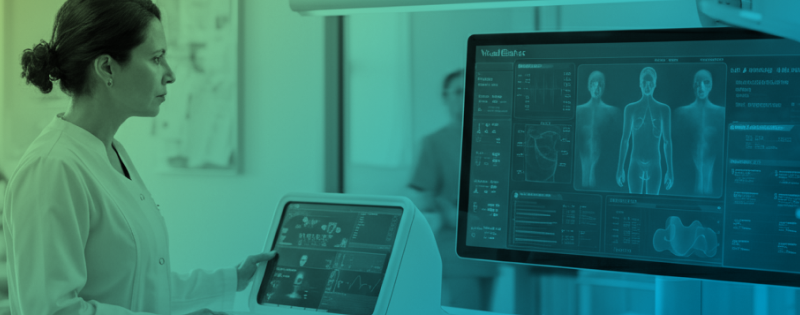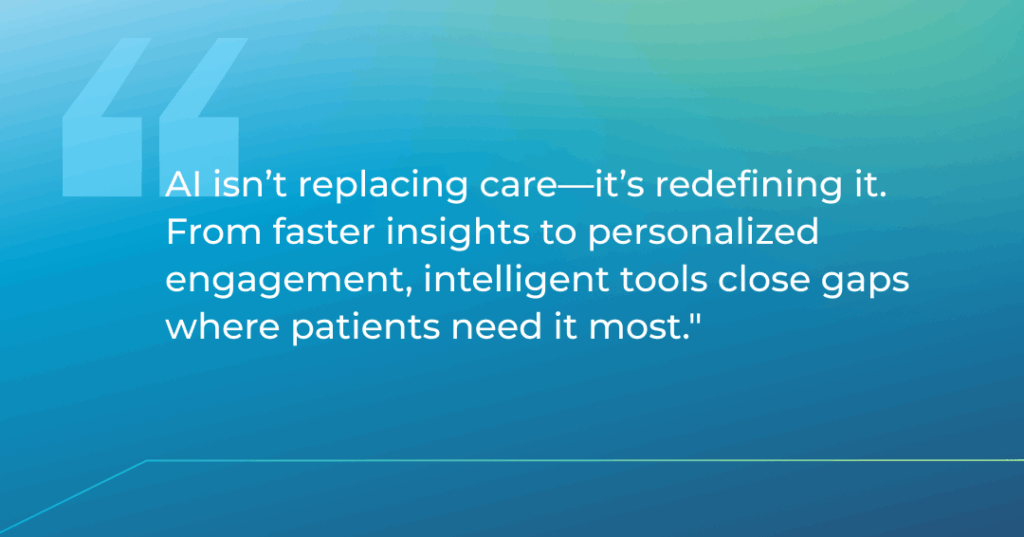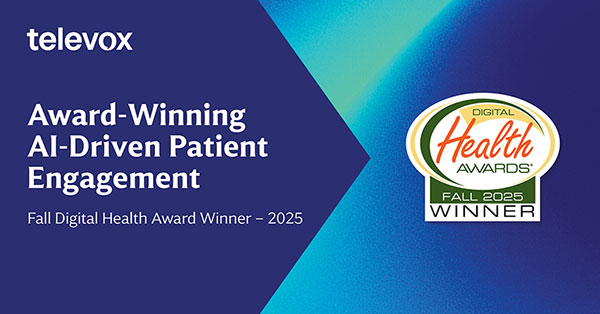Televox is proud to announce that its Enterprise Edition SMS solution has been awarded Gold…

Best AI Software and Tools for Healthcare: Transforming Patient Care
Even the smallest of gaps can change everything in healthcare. An unanswered call, a delayed follow-up, a missed diagnosis; each one carries consequences that significantly impact a patient’s journey.
Traditional methods are no longer fit to close these gaps. AI is the new answer for major healthcare organizations as they deploy smarter systems to gain faster, more accurate insights.
In return, patients feel more connected to their provider, engage more actively in their care, and experience better outcomes.
This listicle highlights the most advanced AI tools and leading solutions that help stakeholders choose technology tailored to their practice and priorities.
Best AI Healthcare Software for Patient Engagement & Communication
When we talk about using AI to handle patients, we mean automating repetitive tasks that would otherwise eat up most of your staff’s hours. This includes dailies like appointment bookings and reminders, follow-ups, and answering other common questions.
These platforms reach patients through text, email, and phone calls based on each patient’s preference, adding to your patient satisfaction scores. Your practice ultimately benefits by cutting down no-shows and keeping patients in the loop without burning out your team.

TeleVox
TeleVox runs virtual assistants called SMART Agents that handle patient conversations across phone, text, and web. These agents use conversational AI to take care of routine messages while still feeling personal.
Once you set up your workflows, everything runs on its own. The system only routes a case to a specialized agent when something needs special attention.
What sets TeleVox apart from basic chatbots is how it connects to your EHR and other clinical systems. It pulls live data like appointment slots, patient preferences, and demographics, so the responses are highly accurate and relevant for each situation.
Best for: Mid-to-large hospital systems handling thousands of patient contacts daily.
| Pros | Cons |
| Multichannel communication across voice, SMS, and web in one platform. | Different pricing for enterprise versus smaller practices makes budgeting tricky. |
| HIPAA-compliant with HITRUST certification keeps patient data secure. | Smaller clinics with limited IT support might find it too expensive. |
| Automated workflows reduce manual call center and administrative tasks. | Staff may need onboarding support to fully realize more advanced features. |
Klara
Klara centralizes patient communication from all channels in a single inbox. Your staff gets to see the complete conversation every time without having to piece together information by switching between multiple windows.
This AI-powered healthcare software also handles intake forms and pre-visit prep work automatically. That, and it works with most popular EHR systems.
Best for: Small to medium practices wanting to reduce phone volume and centralize patient communication.
| Pros | Cons |
| Patient-focused workflow automation. | Doesn’t have as many advanced automation features as bigger enterprise systems. |
| Known for usability, staff can figure it out without much training. | Some users mention that messages can lag during busy times. |
| Connects well with Athenahealth and ModMed. | Patients need to download an app or log into a portal for some features. |
CipherHealth
CipherHealth promises to patch your scattered communication tasks with organized workflows. Their platform uses a digital orchestration engine that makes it easy to coordinate messaging between patients and staff.
There’s also CipherOutreach that you can use to automate post-discharge follow-ups, preventive care reminders, and chronic disease management. The timely outreach based on every care stage makes CipherHealth one of the best software out there for patient engagement.
Best for: Large hospital networks managing complex patient populations.
| Pros | Cons |
| Orchestration engine handles complicated communication sequences across the care journey. | Takes longer to set up in large health systems with lots of integration needs. |
| Have the best customization for adapting workflows to your specific clinical rules. | Costs more than basic patient messaging platforms. |
| Links up with risk management, safety systems, and employee recognition tools. | Staff need time to learn how to use all the advanced features. |
Best AI Software for Medical Imaging and Radiology
A radiologist may have dozens of pending scans, but AI can determine which ones present life-threatening situations and bring them to the top. The digital scans also catch findings that might be missed during manual analysis.
In emergency departments and hospitals managing high patient volumes, these tools prioritize cases that need immediate attention while routine cases follow normal workflows.
Aidoc
Aidoc recently launched CARE1, which they’re calling a foundation model built specifically for medical accuracy. The software watches for things like brain bleeds, blood clots in the lungs, and spine fractures. When it spots one of these, it immediately pings the right specialist on their phone.
Aidoc notes that their healthcare AI handles over 45 million patients each year, reinforcing the reliability of its accuracy rates.
Best for: Larger hospitals and stroke centers that run through a lot of emergency scans daily.
| Pros | Cons |
| Covers multiple urgent conditions across different parts of the body. | Needs to connect with your existing imaging and messaging systems. |
| Sends instant mobile alerts so specialists can respond fast. | Radiology teams have to adjust how they work. |
| Has processed millions of cases with validation backing it up. | Costs more for smaller hospitals based on patient volume. |
PathAI
PathAI provides AI-powered pathology solutions, which means that their platform analyzes tissue samples using deep learning. The software is consistent in identifying cancer cells as well as other diseases, cutting down the working hours it takes for actual staff to look under the microscope.
The best part is that PathAI’s system pulls algorithms from other pathology companies like Paige and Visiopharm, so you’re not locked with one vendor.
Best for: Hospital pathology labs with high volumes of cancer cases that want more consistent results.
| Pros | Cons |
| FDA-cleared, so it’s validated for real clinical use. | You need digital scanning equipment, not just traditional microscopes. |
| Works with AI tools from multiple companies on one platform. | Pathologists have to learn digital workflows. |
| Supports developing precision medicine treatments. | Upfront costs include both software and scanning hardware. |
Viz.AI
Viz.AI offers FDA-cleared support software that analyzes CT scans and alerts doctors about potential strokes. It uses image-based AI to detect blockages in major blood vessels, but the convenience doesn’t stop there.
Specialists can review the images remotely and coordinate with other experts directly through the platform. All of this complies with HIPAA regulations, ensuring that your specialists can work securely, even when remote.
Best for: Stroke centers and hospital networks that coordinate care between smaller community hospitals and specialized stroke treatment facilities.
| Pros | Cons |
| Built specifically for stroke detection with FDA backing. | Only works for strokes, not other imaging needs. |
| Lets specialists review scans remotely to make quick decisions. | You need stroke protocols and specialists already in place. |
| Cuts down the time between scan and specialist review during emergencies. | License fees add up based on your hospital system’s size. |
AI for Hospital Operations & Workflow Automation
Pick any hospital and you’ll find that its operations involve hundreds of repetitive tasks. AI-driven software and tools take charge of them, so that your staff spends more time on patient care than paperwork.
These systems monitor data from multiple sources, move information on demand, send alerts, and more. No one needs to manually check if supplies are running low or chase down test results. The software does it automatically.
TeleVox
We’ve already listed TeleVox as an excellent AI solution for hospitals looking to automate patient engagement. But the platform also does well in automating the operational side of care transitions.
When a patient is cleared to go home, TeleVox supports the transition by alerting care teams, sending discharge instructions, and prompting patients with follow-up reminders. It also runs check-ins after discharge to ask about symptoms, medication routines, and recovery progress. If a response indicates risk or a missed step, the system flags it for clinical staff to review.
The automated improvements have a significant impact on readmissions. Additionally, because it connects with EHRs, scheduling tools, and pharmacy systems, TeleVox gives care teams a single, clear view of each patient’s discharge journey, ensuring your team does their job with more ease.
Best for: Large health systems running multiple facilities with high patient volumes.
| Pros | Cons |
| Automates discharge coordination across departments and tracks post-discharge compliance. | Setup requires connecting to your EHR. |
| Fewer missed appointments from consistent reminders. | Smaller practices might find the features overwhelming. |
| Reduced readmission rates. | Price increases with your patient count. |
FlowForma
FlowForma lets hospital teams build their own workflows without needing an IT army. You don’t need to be a coding expert. You simply drag and drop to create digital forms and approval processes.
The software handles safety inspections, equipment tracking, patient referrals, discharge planning, inventory management, etc. For instance, you can create a workflow where your staff completes fire safety inspections on their mobile devices, while issues are automatically routed to the right teams and compliance reports are generated in the end on their own.
FlowForma also includes Copilot, which uses AI to build workflow templates. You just describe what you need, and the AI creates a starting point.
Best for: Mid-size to large hospitals focused on compliance and standardization. Good fit if you want different departments controlling their own processes.
| Pros | Cons |
| Non-technical people can build and edit workflows. | Can get messy if workflows aren’t managed well. |
| Detailed logs for regulatory audits. | Complex integrations might need IT help. |
| Quick to adapt when procedures change. | Some features and navigation can feel clunky for new users. |
Epic Systems
Epic is known for scalability in the healthcare industry. Their platform handles massive patient volumes while integrating deeply across different departments. You’re looking at a system that connects imaging, pharmacy, labs, scheduling, billing, etc, all in a single Epic environment.
For workflow automation, Epic’s agentic AI prepares visit information before appointments, runs insurance verification, flags abnormal lab results, and suggests next steps based on clinical protocols.
Physicians can also rely on the AI to draft patient messages, queue prescription orders, and summarize handoff notes, saving time while improving communication.
Best for: Large health systems prioritizing deep integration and willing to commit to Epic’s ecosystem.
| Pros | Cons |
| Handles the entire hospital workflow from charting to billing. | Significant upfront implementation costs and timeline. |
| Deep integration across all clinical and administrative systems. | Requires substantial training for staff adoption. |
| Continuous AI updates with 100+ features in development. | Less flexible for customization outside Epic’s framework. |
AI Software for Remote Patient Monitoring (RPM)
Remote capabilities help physicians monitor patients who are not capable of coming to their clinic or area of practice. Waiting for the next visit may be dangerous, so patients utilize RPM devices to send readings such as blood pressure and blood glucose levels into a specialized dashboard. The software then alerts care teams if needed so they can intervene before any major complications.
HealthArc
HealthArc doesn’t stop at remote monitoring. Their platform also combines care coordination, billing, and automated workflows for improved efficiency.
Patients don’t even need a good internet connection at home because they can connect the RPM devices through Bluetooth or cellular.
As for the dashboard, it’s clean and pulls data from EHR systems to ensure doctors always have the full picture.
Best for: Mid to large practices that want an all-in-one platform with billing and compliance.
| Pros | Cons |
| Covers RPM, chronic care, and billing. | Can feel overwhelming for small practices. |
| Works well with major EHRs. | Some training is required for staff. |
| Supports cellular devices. | Device costs can add up. |
Athelas
Athelas is different from most RPM platforms because it includes its own diagnostic device, Athelas Home. The device allows you to run blood tests at home, something especially valuable for oncology patients or people with immune concerns.
On the software side, Athelas supports chart integration, automated billing, and even AI-based scribing to reduce admin work.
Best for: Clinics that need more than just vitals monitoring.
| Pros | Cons |
| In-home blood diagnostics. | Too advanced for basic RPM needs. |
| Automated billing is built in. | Hardware costs can be higher. |
| Excellent EHR integration. | Limited device variety. |
HumHealth
HumHealth is another AI software that is known in healthcare for its flexibility. Their platform supports multiple FDA-cleared devices, and it even offers a 4G hub for patients without strong WiFi.
Your care teams can track the data based on their roles, meaning doctors, nurses, and other staff get their own dashboards. Everyone sees what matters to them.
Alongside RPM, HumHealth also covers chronic care management and wellness programs.
Best for: Practices serving older or rural populations, especially those billing Medicare for RPM and chronic care.
| Pros | Cons |
| Combines RPM and chronic care. | Limited lab system integrations. |
| 4G hub supports patients without WiFi. | May not scale easily to large hospital networks. |
| Interfaces tailored to each user role. | Less recognized outside the U.S.. |
Best AI Tools for Drug Discovery & Precision Medicine
Finding new drugs and medicines takes years and costs billions. AI software has helped cut that down for hospitals and research labs. These systems automatically scan millions of molecular combinations and give a probability of which ones can work together.
Atomwise
Atomwise offers AtomNet, an AI-driven platform that predicts which molecules stick to which proteins. It has a far better success rate in finding new compounds than random screening. Most recently, Atomwise shifted from just helping other companies to building their own drugs by announcing its first drug candidate: an oral medication targeting TYK2 for autoimmune diseases.
Best for: Research universities and pharma companies hunting for treatments for rare diseases where typical screening costs too much.
| Pros | Cons |
| Finds completely new compound structures that labs wouldn’t think to test. | Needs significant computing power and expertise. |
| Screens compounds much faster than physical lab tests. | Most predictions haven’t been through full clinical trials yet. |
| Access to 3 trillion molecules in their database. | You still need wet lab work to confirm what the AI suggests. |
Recursion
Recursion runs a platform that photographs cells, applies machine learning, and automates experiments. They’ve collected 50 petabytes of biological data to train their models. One example: they identified a target, matched it with a molecule, and got FDA clearance for human trials in under 18 months. That’s remarkably fast.
Best for: Biotech and pharma groups running multiple drug programs, who need scalability across different diseases.
| Pros | Cons |
| Huge proprietary dataset gets smarter with each experiment. | Complex system needs dedicated expert biology staff. |
| Moved drugs from computer to clinic faster than the industry average. | The pipeline is mostly early-stage. |
| Partnerships with big pharma companies back up their claims. | Expensive to get full platform access. |
AlphaFold
AlphaFold accurately predicts how proteins bind to DNA, RNA, and drug-like molecules. The AI takes an amino acid sequence and determines the protein’s 3D shape. This is important because you have to know a protein’s shape in order to make drugs that bind to it properly.
Researchers use it for free, which benefits smaller laboratories and researchers who are unable to afford costly structural biology equipment.
Best for: Universities and small biotech firms that need free structural data for early research.
| Pros | Cons |
| Free database with 214 million protein structures. | Predictions need lab confirmation before you can trust them fully. |
| Google DeepMind keeps updating it with new features. | Only predicts structures, doesn’t design the actual drug molecules. |
| Accuracy rivals expensive X-ray crystallography and cryo-EM. | Doesn’t show how proteins actually move or function in cells. |
Key Considerations When Choosing an AI Healthcare Software Solution
Finding an AI-driven healthcare platform is the easy part. There are several solutions available in the market for you to choose from. The hard part is making sure that the software has the tools and features your practice actually needs. Otherwise, you’re just investing in advanced software that adds to your problems instead of solving them.
- Check for encryption, audit logs, and role-based access controls. The vendor should be following HIPAA requirements and also be ready to sign a Business Associate Agreement.
- Look for seamless integration with your current EHR system. Without this, staff will end up entering the same data twice.
- Understand how the vendor charges. Is it per user, per device, or a flat rate? It’s also wise to look for hidden costs like hardware fees and maintenance.
- Ask about vendor-led training, documentation, and live support. Confirm how much time your team will need before the system becomes part of daily use.
- Make sure the software can handle more patients, more users, and new modules as your practice grows. Switching later is costly and disruptive.
- Check response times, service level agreements, and upgrade policies. Reliable support makes adoption much smoother.

Why Choose TeleVox as Your AI-Powered Patient Engagement Platform
TeleVox stands out because we deliver more than just another chatbot tethered to a website. Our platform is embedded directly into the systems you already depend on. Your EHRs and scheduling tools; everything connects under one roof. It’s why our AI-driven SMART Agents always have the data your staff or patients need.
This real-time, bi-directional exchange also makes scaling easy. TeleVox is meant to handle high conversation volumes, so whether you’re running one clinic or a multi-site network, you can launch new workflows and outreach programs quickly without leaning heavily on IT.
The results speak for themselves. Our ROI calculator shows you the potential impact on no-show rates, referral closure, and recovered revenue. Healthcare organizations that partner with us consistently see stronger capacity utilization, lower operational costs, and better patient retention.
With accolades like Frost & Sullivan’s 2024 Customer Value Leadership award showing the market is taking notice, it’s time you did as well. Scheduled a demo today, and let TeleVox guide you towards big gains.



